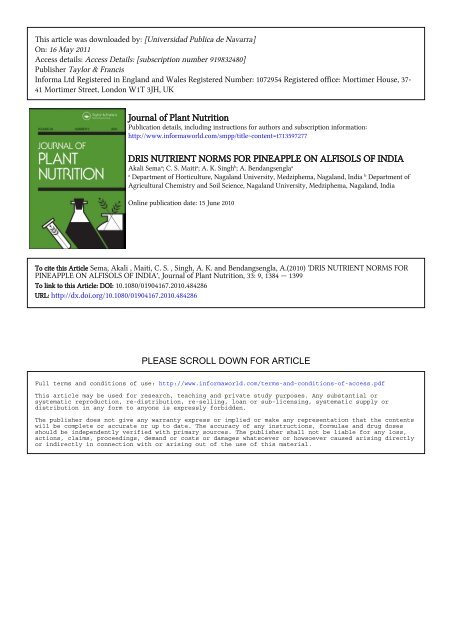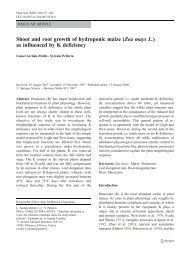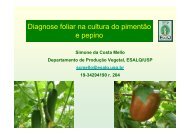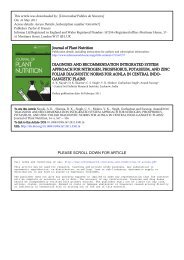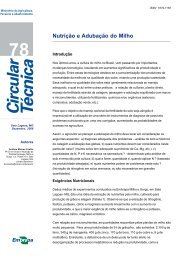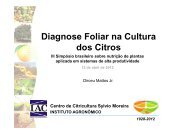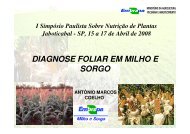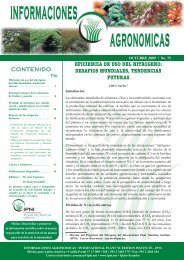Journal of Plant Nutrition DRIS NUTRIENT NORMS FOR ...
Journal of Plant Nutrition DRIS NUTRIENT NORMS FOR ...
Journal of Plant Nutrition DRIS NUTRIENT NORMS FOR ...
Create successful ePaper yourself
Turn your PDF publications into a flip-book with our unique Google optimized e-Paper software.
<strong>DRIS</strong> Nutrient Norms for Pineapple 1389Downloaded By: [Universidad Publica de Navarra] At: 10:21 16 May 2011FIGURE 2 Annual variation leaf phosphorus concentration.FIGURE 3 Annual variation leaf potassium concentration.
<strong>DRIS</strong> Nutrient Norms for Pineapple 1391Downloaded By: [Universidad Publica de Navarra] At: 10:21 16 May 2011FIGURE 5 Annual variation leaf magnesium concentration.The annual accumulation pattern <strong>of</strong> Ca and Mg showed a range <strong>of</strong> 0.08–0.18% (mean 0.12%) and 0.07–0.34% (mean 0.17%). The variation curve <strong>of</strong>Ca and Mg can be identified by lower portion (0.08–0.14% and 0.07–0.19%),middle portion (0.11–0.18% and 0.14–0.21%), and again lower bottom endportion <strong>of</strong> the curve (0.08–0.13% and 0.10–0.17%) with distinct redistribution<strong>of</strong> nutrients. These observations suggested that the mean concentration<strong>of</strong> different nutrients during the stable 4th to 5th month <strong>of</strong> growth correspondedwell to mean annual concentration or even with mean concentration<strong>of</strong> all the three seasons. The higher correlation values <strong>of</strong> differentnutrients (concentration during 4th to 5th month) with fruit yield (r = 0.611,P = 0.01 for leaf N vs yield; r = 0.702, P = 0.01 for leaf P vs fruit yield; r =0.401, P = 0.05 for leaf K vs fruit yield; r = 0.732, P = 0.01 for leaf Ca vs yield;and r = 0.596, P = 0.01) for leaf Mg vs yield) than the correlation values forrest <strong>of</strong> the period (r = 0.289–0.316 for leaf N vs yield; r = 0.311–0.372 forleaf P vs yield; r = 0.189–0.204 for leaf K vs yield; r = 0.201–0.254 for leaf Cavs yield; and r = 0.323–0.355 for leaf Mg vs yield) warranted that 4th- to -5thmonth-old growth is the ideal time for the leaf sampling.A large variation in micronutrient concentration was prominently observedover a growing season. On the basis <strong>of</strong> pooled data for three seasons,the variation in concentration <strong>of</strong> different nutrients was observed as93.2–117.0 mg g −1 Fe (mean 102.6 mg g −1 ), 20.4–45.4 mg g −1 Mn (mean29.3 mg g −1 ), 4.4–7.2 mg g −1 Cu (mean 5.4–mg g −1 ), and 3.5–9.7 mg g −1 Zn(mean 7.1 mg g −1 ). All these micronutrients (Figures 6, 7, 8, and 9) showed
1392 A. Sema et al.Downloaded By: [Universidad Publica de Navarra] At: 10:21 16 May 2011FIGURE 6 Annual variation leaf iron concentration.FIGURE 7 Annual variation leaf manganese concentration.
<strong>DRIS</strong> Nutrient Norms for Pineapple 1393Downloaded By: [Universidad Publica de Navarra] At: 10:21 16 May 2011FIGURE 8 Annual variation leaf copper concentration.FIGURE 9 Annual variation leaf zinc concentration.
1394 A. Sema et al.Downloaded By: [Universidad Publica de Navarra] At: 10:21 16 May 2011minimum change in concentration during 4th- to -5th month <strong>of</strong> growth(98.2–98.5 mg g −1 Fe, 20.4–23.3 mg g −1 Mn, 4.4–5.5 mg g −1 Cu, and 8.5–8.7mg g −1 Zn) than the changes during rest <strong>of</strong> the period (93.2–117.0 mg kg −1Fe, 25.7–43.4 mg kg −1 Mn, 4.9–7.2 mg kg −1 Cu, and 3.5–9.7 mg kg −1 Zn)suggesting that ideal time for leaf sampling is when leaves are 4- to 5-monthsold. This was further supported by higher correlation between concentration<strong>of</strong> different nutrients at 4th-5th month <strong>of</strong> leaf age and fruit yield (r =0.796, P = 0.01 for leaf Fe vs yield; r = 0.804, P = 0.01 for leaf Mn vs yield;r = 0.583, P = 0.01 for leaf Cu vs yield; and r = 0.811, P = 0.01 for leaf Zn vsyield) than correlation values worked out for rest <strong>of</strong> the periods <strong>of</strong> sampling(r = 0.469–0.512, P = 0.01 for leaf Fe vs yield; r = 0.211–0.309 for leaf Mn vsyield; r = 0.451–0.462, P = 0.01 for leaf Cu vs yield; and r = 0.216–0.281 forleaf Zn vs yield). Verawudh et al. (1993) observed highest yield (71.4 tonsha −1 ) <strong>of</strong> pineapple (cv ‘Smooth Cayenne’) associated with concentrationranges <strong>of</strong> different micronutrients viz., 26.5–36.2 ppm Fe, 5.6–9.0 ppm Cu,13.8–14.4 ppm Zn, and 14.2–19.7 ppm B in 12- month-old D-leaf.Leaf Analysis Based <strong>DRIS</strong> NormsLeaf analysis as a method <strong>of</strong> assessing the crop nutrient requirementsis based on the assumption that within certain limit, there exists a positiverelation between doses <strong>of</strong> the nutrient supplied, leaf nutrient content, andyield (Srivastava et al., 2001). The concentration <strong>of</strong> different nutrients fromthe developed data bank varied in the range <strong>of</strong>: 0.92–2.32% N, 0.30–0.81%P,0.83–1.80% K, 0.16–0.45% Ca, 0.22–0.70% Mg, 58.2–172.9 ppm Fe, 28.5–62.1ppm Mn, 5.2–13.3 ppm Cu, and 8.2–21.3 ppm Zn. While the yield on the basis<strong>of</strong> each sub-plot varied from 21.8 to 94.3 tons ha −1 (data not presented).The <strong>DRIS</strong> norms developed in relation to fruit yield <strong>of</strong> 55–72 tons ha −1 predictedoptimum value <strong>of</strong> different nutrients as: 1.21–1.85% N, 0.13–0.18% P,1.19–1.62% K, 0.27–0.35% Ca, 0.43–0.56% Mg, 78.4–102.5 ppm Fe, 41.5–58.3ppm Mn, 7.4–10.2 ppm Cu, and 12.2–15.8 ppm Zn (Table 1). A proportionatelyhigher leaf nutrient level were suggested to be maintained to get thefruit yield up to or beyond > 88 tons ha −1 . The optimum values <strong>of</strong> N andK derived from <strong>DRIS</strong>-based norms were observed much closer to values assuggested by Angeles et al. (1990) who determined optimum value <strong>of</strong> N, P,and K as 1.43%, 0.25%, and 3.25%, respectively, through <strong>DRIS</strong> based normswhich changed to 1.43%, 0.15%, and 2.77% derived from existing criticalvalues.The leaf nutrient standards <strong>of</strong> varying dimensions are frequently suggestedto take into account, the regional differences in climate and soil sitecharacteristics. It remains to be seen that the diagnostic norms derived fromspecific index leaves and fields <strong>of</strong> varying productivity levels, categorized intodeficient or optimum in different leaf nutrients on the basis <strong>of</strong> nutrient concentration,has the same utility to that <strong>of</strong> norms developed through leaves
<strong>DRIS</strong> Nutrient Norms for Pineapple 1395TABLE 1 Leaf nutrient norms determined from <strong>DRIS</strong> based analysis for pineapple grown in tropicalIndiaNormsNutrients Deficient Low Optimum High ExcessDownloaded By: [Universidad Publica de Navarra] At: 10:21 16 May 2011N(%) 2.10P(%) 0.22K(%) 1.82Ca (%) 0.42Mg (%) 0.70Fe (ppm) 168.1Mn (ppm) 61.6Cu (ppm) 12.3Zn (ppm) 19.6Yield (tons ha −1 ) 88sampled at other crop developmental stages (leaving the index samplingperiod) in order to make <strong>DRIS</strong>, a more flexible monitoring tool withoutaffecting the production at any stage <strong>of</strong> crop (Srivastava et al., 2008).Soil Analysis-Based <strong>DRIS</strong> NormsSoil analysis method rests on the assumption that roots will extract nutrientsfrom the soil in a manner comparable to chemical soil extractants, andthat there is a simple direct relationship between the extractable concentration<strong>of</strong> nutrients in soil and their uptake by plants (Egashira et al., 1990).However, though there has been considerable uniformity among the soil testmethods in conventional use, a great diversity still arises in the interpretation<strong>of</strong> these tests. The central element in developing the soil test norms usinga particular test crop is the optimum value. Use <strong>of</strong> <strong>DRIS</strong> with soil data providesas advantage <strong>of</strong> taking into account, the nutrient balance and rankingnutrients in terms <strong>of</strong> abundance relative to optimum levels. Optimizing soilfertility has recently emerged as a new field <strong>of</strong> investigation, which ensuresmaximum yield under a wide range <strong>of</strong> soil conditions. Various soil fertilityparameters <strong>of</strong> developed data bank varied as: 4.3–6.5 soil pH, 0.72–2.10 gkg −1 organic carbon, 104.1–190.4 mg kg −1 availableN,7.8–17.2mgkg −1 P,162.1–290.4 mg kg −1 K, 1.52–9.12 meq 100 g −1 Ca, 1.12–7.12 meq 100 g −1Mg, 74.3–182.1 mg kg −1 Fe, 0.81–4.16 mg kg −1 Mn, 0.14–0.52 mg kg −1 Cu,and 0.38–1.28 mg kg −1 Zn (data not presented).The <strong>DRIS</strong> norms developed from above databank predicted the optimumvalues <strong>of</strong> pH 5.6–6.5, organic carbon 1.06–1.76%, available N145.4–167.1 mg kg −1 ,P-9.2–12.9mgkg −1 , K 206.9–234.2 mg kg −1 ,Ca3.83–5.65 meq 100 g −1 , Mg 3.43–5.13 meq 100 g −1 , Fe 100.7–138.2 mg kg −1 ,Mn 1.53–2.66 mg kg −1 , Cu 0.23–0.33 mg kg −1 , Zn 0.69–0.93 mg kg −1 in relationto fruit yield <strong>of</strong> 1051–1350 g fruit −1 (Table 2). A soil-testing program,
1396 A. Sema et al.TABLE 2 Soil fertility norms determined from <strong>DRIS</strong> based analysis for pineapple grown in tropicalIndiaNormsParameters Deficient Low Optimum High ExcessDownloaded By: [Universidad Publica de Navarra] At: 10:21 16 May 2011pH 6.4 ∗∗Org. C (g kg −1 ) 1.98N(mgkg −1 ) 182.7P(mgkg −1 ) 16.4K(mgkg −1 ) 282.9Ca (meq 100 g −1 ) ∗∗∗ 7.12Mg(meq 100 g −1 ) ∗∗∗ 6.89Fe (mg kg −1 ) 162.4Mn (mg kg −1 ) 3.12Cu (mg kg −1 ) 0.48Zn (mg kg −1 ) 1.10Yield (tons ha −1 ) 88∗ Very low, ∗∗ Very excess, ∗∗∗ Exchangeable form.thus, can identify areas, which are either under- or over-fertilized to enablemore efficient use <strong>of</strong> fertilizers.Validation <strong>of</strong> Optimum ValuesPast studies (Srivastava and Singh, 2006) have established that maximumyield is achieved within the optimum range. Since, development <strong>of</strong>nutrient diagnostics is a time consuming exercise, the nutrient test valuesobtained from highly productive fields could well serve as reference values,and cross validate through either crop response studies or statistical modelling.The optimum nutrient values <strong>of</strong> D-leaves and soil available nutrientswere observed very close to the range <strong>of</strong> values derived from productiveplots (Table 3). The leaf/soil test values <strong>of</strong> highly productive fields, hence,matches to the diagnoses made by <strong>DRIS</strong>.The <strong>DRIS</strong> norms obtained in the current study has superior precisionover the others. The fact that the norms derived from critical levels proved tobe as effective as those derived from the data base points to the importance<strong>of</strong> assessing nutrient balance when making diagnoses. By calculating theratios <strong>of</strong> the critical values, balance is automatically built into the diagnosis,which the critical value approach is unable to do.Distribution <strong>of</strong> Nutrient ConstraintsNutrient deficiencies, if not addressed in time through suitable diagnosticnorms, will cause a recurrent loss in production and continue to impartimbalances in the production economics. In all cases, as the limiting nutrientsare supplied, the nutrient balance index (NBI), being the sum <strong>of</strong> the
<strong>DRIS</strong> Nutrient Norms for Pineapple 1397TABLE 3 Comparison <strong>of</strong> <strong>DRIS</strong>-based nutrient diagnostics with productive sub-plots <strong>of</strong> pineappleProductive sub-plots ∗∗<strong>DRIS</strong>-based optimum <strong>DRIS</strong>-based optimum soilleaf nutrient norms fertility norms Leaf nutrients Soil fertilityNutrients (%) (mg kg −1 ) (%) (mg kg −1 )Downloaded By: [Universidad Publica de Navarra] At: 10:21 16 May 2011N 1.21–1.85 145.4–167.1 1.46–1.92 132.1–158.4P 0.13–0.18 9.2–12.9 0.12–0.14 8.1–11.2K 1.19–1.62 206.9–234.2 1.42–1.60 189.3–210.3Ca ∗ 0.27–0.35 3.83–5.65 0.28–0.38 2.94–4.62Mg ∗ 0.43–0.56 3.43–5.13 0.40–0.48 3.04–4.12Fe(ppm) 78.4–102.5 100.7–138.2 82.1–100.3 89.9–114.8Mn(ppm) 41.5–58.3 1.53–2.66 38.3–52.6 1.14–2.12Cu(ppm) 7.4–10.2 0.23–0.33 6.4–9.2 0.24–0.30Zn(ppm) 12.2–15.8 0.69–0.93 13.2–14.6 0.66–0.84Yield(tons ha −1 ) 55–72 55–72 69–94 69–94∗ meq 100 g −1 , ∗∗ Pooled values.<strong>DRIS</strong> indices irrespective <strong>of</strong> sign, progressively decreases to a low value, thusindicating that nutrition is coming into balance (Beaufils, 1973). Nutrientdeficiencies <strong>of</strong> P, Ca, Mg, N, Zn, and Cu due to their negative values indecreasing order (181 → 21) was observed (Table 4) through leaf analysis.While, other nutrients namely Fe, Mn, and K with increasing positive indices(91 to 257) were observed in high to excess limit. A large positive nutrientindex indicates that the corresponding nutrient is present in relatively excessivequantity. Using progressive nutrient diagnosis, if the first limiting factorP is corrected by its supply, the next nutrient that will limit the yield is Ca.Further, if P and Ca are satisfied, the next limiting nutrient is Mg followedby N, Zn, and Cu.Mean <strong>DRIS</strong> indices developed from soil analysis-based databank suggestedlow to deficient level <strong>of</strong> Ca, P, Mg, Org. C, pH, Zn, N, Cu, and Mndue to their negative values in decreasing order (142 to 17). While, those<strong>of</strong> K and Fe on account <strong>of</strong> their increasing positive indices (289 to 391)were found in high to excess limit (Table 5). Various nutrients in order <strong>of</strong>decreasing influence on yield were rated as P < Ca < Mg < N < Zn < Cu
1398 A. Sema et al.TABLE 5 Nutrient constraints diagnosis using soil analysis based <strong>DRIS</strong> indices in pineapple(summarized form)Nutrients found YieldParameters ––––––––Nutrients found low and deficient–––––––– high and excess (tons ha −1 )Nutrients Ca P Mg Org. C pH Zn N Cu Mn K Fe —Status 1.58 8.6 1.28 0.78 4.6 0.58 121.4 0.20 1.20 289.1 159.3 37<strong>DRIS</strong> indices −142 −132 −99 −81 −78 −61 −42 −28 −17 289 391 –Downloaded By: [Universidad Publica de Navarra] At: 10:21 16 May 2011revealed slightly different nutrients to be ordered as Ca < P < Mg < Zn
<strong>DRIS</strong> Nutrient Norms for Pineapple 1399Downloaded By: [Universidad Publica de Navarra] At: 10:21 16 May 2011Kar, P. L., D. Sanyal, A. H. Mondal, and V. L. Ruata 1992. Note on foliar micro-nutrient composition <strong>of</strong>pineapple grown under foothills <strong>of</strong> Nagaland. Indian <strong>Journal</strong> <strong>of</strong> Horticulture 49: 231–233.Letzsch, W. S., and M. E. Sumner 1984. Effect <strong>of</strong> population size and yield level in selection <strong>of</strong> Diagnosisand Recommendation Integrated System (<strong>DRIS</strong>) norms. Communications in Soil Science & <strong>Plant</strong>Analysis 15: 997–1006.Li J., X. X. Li, J. C. Peng, and G. Q. Zhuang. 1999. Effect <strong>of</strong> five mineral elements on nutritional status<strong>of</strong> Navel orange tree. <strong>Journal</strong> <strong>of</strong> Hunan Agriculture University 25: 36–39.Lindsay, W. L, and W. A. Norvell. 1978. Development <strong>of</strong> DTPA test for Zinc, iron, manganese and copper.Soil Science Society <strong>of</strong> America <strong>Journal</strong> 42: 421–428.Malavolta, E., S. A. Oliveika, and G. C. Vitti. 1993. The use <strong>of</strong> diagnosis recommendation integrated system(<strong>DRIS</strong>) to evaluate the nutritional status <strong>of</strong> healthy and blight affected citrus trees. In: Proceedings <strong>of</strong>the Eight International. Colloquium on Optimization <strong>of</strong> <strong>Plant</strong> <strong>Nutrition</strong>, eds.M.A.C.Fragoso,andM.L.van Beusichem, pp. 157–159. Dordrecht, the Netherlands: Kluwer Academic Publishers.Mohammed-Selamat, B. M., and R. Masaud. 2005. Growth, yield and quality <strong>of</strong> pineapple cv. Josapine asaffected by density and fertilizer rate grown on sandy soil in Malaysia. Acta Horticulturae 666: 193–201.Reuter, D. J., and J. B. Robinson. 1987. <strong>Plant</strong> Analysis: An Interpretation Manual. Melbourne: Inkata Press.Singh, H. P., K. M. Ganapathy, and H. C. Dass. 1978. Evaluation <strong>of</strong> physiological constant for estimation<strong>of</strong> leaf area in pineapple (Ananas comosus (L.) Merr.) Science & Culture 44: 409–410.Srivastava, A. K, and S. Singh. 2006. Diagnosis <strong>of</strong> nutrient constraints in citrus orchards <strong>of</strong> humid tropicalIndia. <strong>Journal</strong> <strong>of</strong> <strong>Plant</strong> <strong>Nutrition</strong> 29: 1061–1076.Srivastava, A. K., and S. Singh. 2008. <strong>DRIS</strong> norms and their field validation in Nagpur mandarin (Citrusreticulata Blanco). <strong>Journal</strong> <strong>of</strong> <strong>Plant</strong> <strong>Nutrition</strong> 31: 1091–1107.Srivastava, A. K., S. Singh, and L. G. Albrigo. 2008. Diagnosis and remediation <strong>of</strong> nutrient constraints incitrus. Horticultural Reviews 34: 277–363.Srivastava, A. K., S. Singh, A. D. Huchche, and L. Ram. 2001. Yield-based leaf and soil-test interpretationsfor Nagpur mandarin in central India. Communications in Soil Science and <strong>Plant</strong> Analysis 32: 585–599.Subbaiah, B. V., and G. L. Asija. 1956. A rapid procedure for the estimation <strong>of</strong> available nitrogen in soils.Current Science 25: 259–260.Subramanian, T. R., K. L. Chadha, H. K. Sreenivasa Murthy, and K. R. Melanta. 1974. Studies on nutrition<strong>of</strong> pineapple III. Effect <strong>of</strong> varying levels <strong>of</strong> NPK on leaf nutrient status in variety Kew in low fertilitysoil. Indian <strong>Journal</strong> <strong>of</strong> Horticulture 31: 219–222.Sumner, M. E. 1977. Use <strong>of</strong> the <strong>DRIS</strong> system in foliar diagnosis <strong>of</strong> crops at high yield levels. Communicationsin Soil Science & <strong>Plant</strong> Analysis 8: 251–268.Verawudh, J., D. P. Bartholonew, and K. G. Rohrbach. 1993. Effect <strong>of</strong> micronutrients on growth, nutrientscontent in D-leaf and yield <strong>of</strong> pineapple. Acta Horticulturae 334: 241–245.Walworth, J. L., and M. W. Sumner. 1987. The diagnosis and recommendation integrated system (<strong>DRIS</strong>).Advances in Soil Science 6: 150–188.


